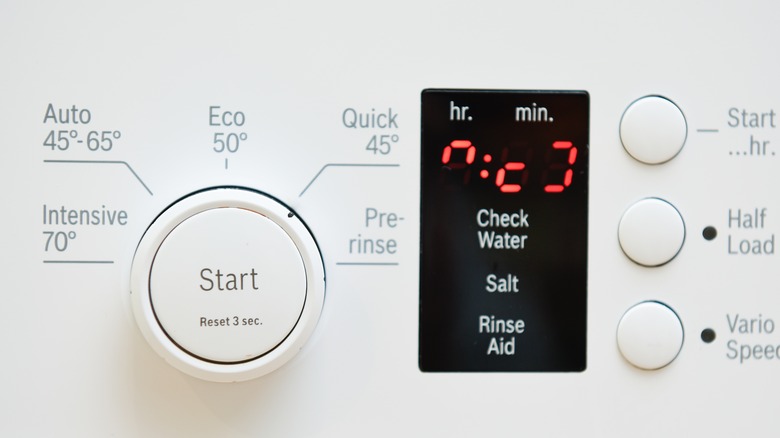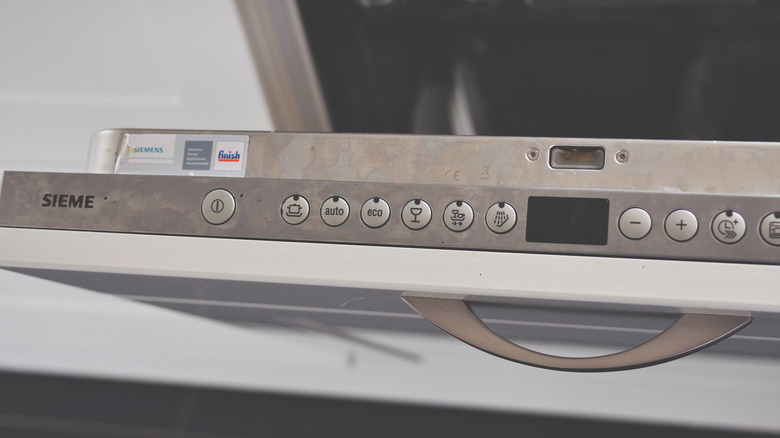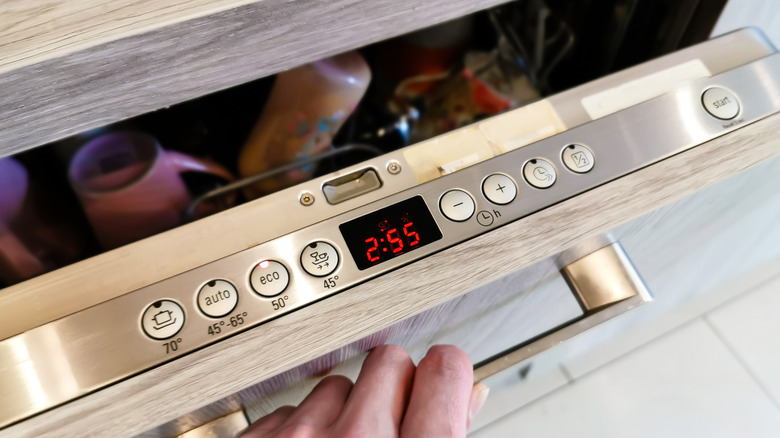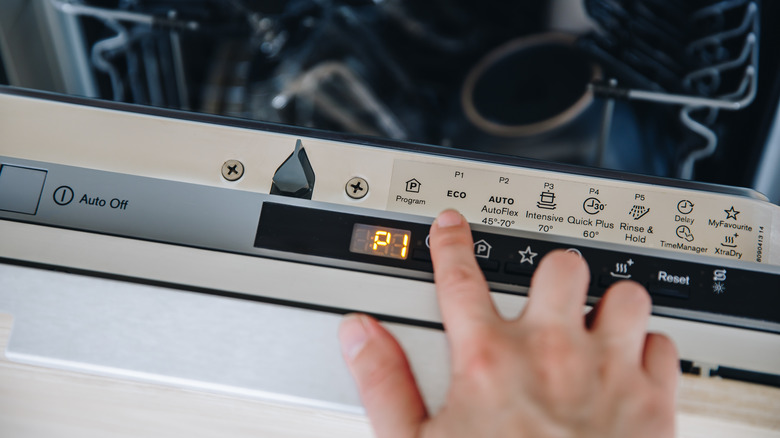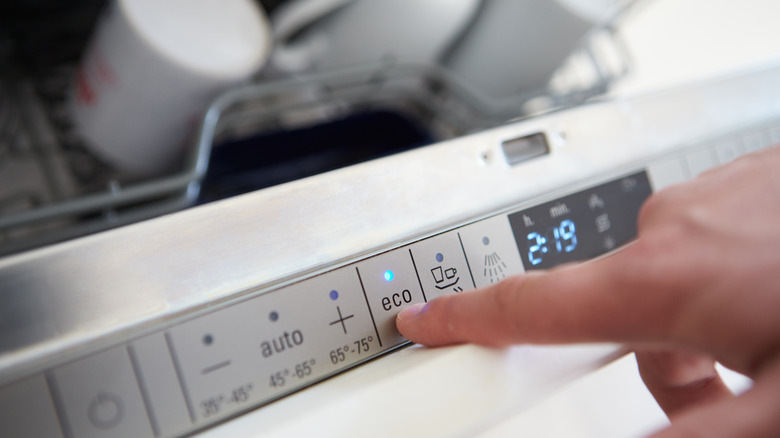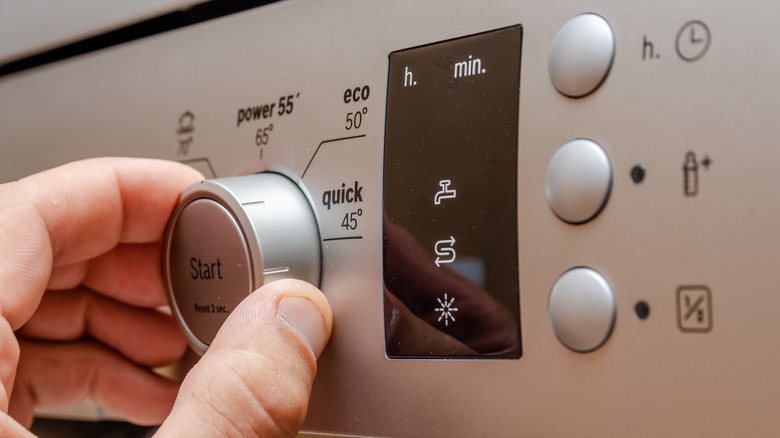What's The Right Dishwasher Setting For Each Type Of Load?
Undoubtedly, the dishwasher is one of the most useful appliances in every home. It helps you get your dishes ready for the next meal while saving you precious time that you would have otherwise wasted handwashing. Moreover, per Reviewed, a dishwasher uses up to three times less water than handwashing. Although modern dishwashers have many functions, homeowners are often guilty of using only one setting regardless of the type of load. Keep in mind that using the right dishwasher function will allow you to get the most out of each washing cycle.
But how do you determine which function is suitable for a particular load? Well, it all comes down to how dirty your dishes are; some are designed to handle simple day-to-day tasks, while others are for tough stains. Although dishwasher functions vary from brand to brand, here is a quick rundown of the standard settings and how best you can use them to get your dishes fresh and ready for the next meal.
Normal setting
If you have not yet cared to find out what the other functions do on your appliance, then you probably are using the typical standard setting. This dishwasher wash cycle is ideal for washing regular dishes with little to no tough stains. Unlike others, the normal setting doesn't need more than two hours to clean the entire load, mentions Maytag. In addition, this option also uses less water for the whole of the cycle, heated between 130 and 140 degrees Fahrenheit.
Because the setting is not as thorough as other options and the fact that it takes significantly less water makes it quite economical as far as energy consumption is concerned. The good news is that this function is found in almost all dishwashers except the extremely low-priced options. For the most part, this setting will eliminate all leftover mess and dry your dishes well. However, be sure to load the dishwasher properly to get the best out of every wash cycle.
Heavy setting
As the name suggests, the heavy setting on the dishwasher is reserved for the toughest washes. This option removes the tough and sticky grime from plates and pans. Essentially, any dirt that would otherwise need to be soaked before washing, for instance, baked-on grime, should be cleaned using the heavy setting on your appliance. Compared to the normal function, the heavy option uses more water heated to relatively higher temperatures to help break down and soften substantial stains.
How hot the water gets for this cycle varies from brand to brand. According to KitchenAid, this particular cycle can take close to three hours to wash and dry. However, since not every appliance comes equipped with this function, you might need to soak your dishes before putting them in the dishwasher. Keep in mind that this might not be the most energy-efficient mode, but it will help get rid of all the touch stains from your plates, pans, and pots.
Auto wash
The sensor or automatic wash might just be the revolutionary function for dishwashing appliances today. It is worth acknowledging that this is a relatively new setting found only in the pricier options. Unlike the other settings that need you to determine how dirty your dishes are beforehand, the sensor wash setting does it all for you. This function not only detects the toughness of the stains and grime but also sets the dishwasher to the ideal setting, cycle duration, water temperature, and intensity of the process, via Whirlpool.
You no longer have to think or guess which wash setting is right for a particular load; you can now comfortably delegate the dishwashing task. Keep in mind that the auto wash option might have a different name on your dishwasher; however, they all serve the same purpose. The beauty of this wash setting is that you can have mixed-load cleaning simultaneously.
Eco wash
Are you looking for a wash cycle to help you cut down on power bills? You should try the eco-wash. This option uses significantly less water at relatively lower temperatures than other wash settings. Although the cycles that use more water at higher temperatures are often quite effective, they also tend to use more electricity. However, to save on energy, there are some compromises that you need to contend with if you choose this function. Just-in Time Appliance Repair notes that because this wash cycle heats water to a lower temperature, you should expect the dishes to take relatively longer to clean.
You should also be aware that this setting doesn't use heated air for drying; instead, it relies on air drying, which is not always the best for drying dishes. Essentially, the main things adjusted for this setting include the amount of water, wash duration, and water temperature. That said, it is best to use this setting for everyday dishes, not baked-on pots.
Quick wash
What do you do when you've forgotten to run the wash and need clean plates as soon as possible? This is where the quick wash function swings into action. Similar to the auto wash cycle, this function also comes in various names, for instance, express, rapid, or turbo wash, to mention a few. To get your dishes ready in record time, this setting uses more water or higher temperatures to hasten the process.
With that in mind, you can already guess that this setting might not be the most energy-efficient. Depending on the model, the quick wash function can take one hour or less to prepare the dishes for dinner, per Which?. Because of the nature of the cleaning process, this option might not be ideal for every load. Although the rapid wash method differs for all models, this setting is suitable for lightly soiled dishes with little to no tough stains.
